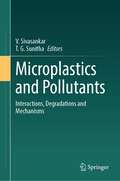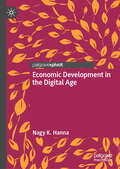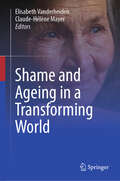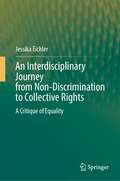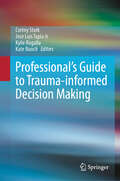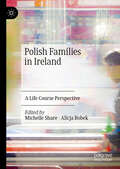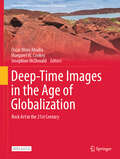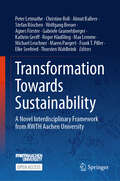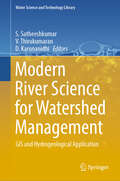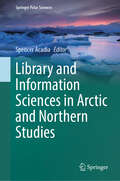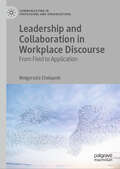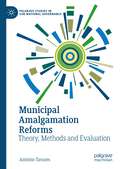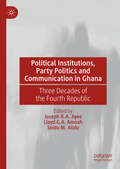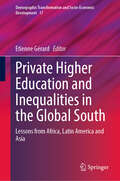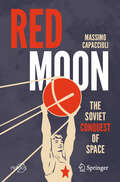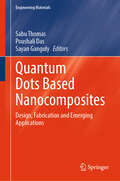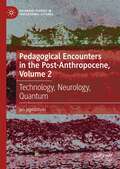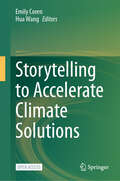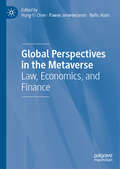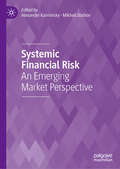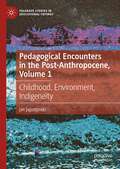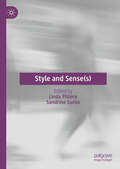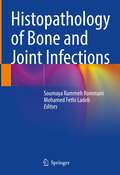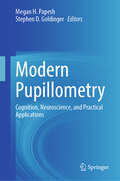- Table View
- List View
Microplastics and Pollutants: Interactions, Degradations and Mechanisms
by V. Sivasankar T. G. SunithaThis volume discusses the adsorptive profiles of microplastic (MP) pollutants, covering their structural identity, sorption ability and degradation due to photolytic, hydrolytic, mechanical, and other environmental factors. In addition to the quantitation of (MPs) in the environment, the book unveils the deleterious effects on aquatic species and humans due to adsorbed inorganic/organic contaminants on the surface of MPs. The present book finds its uniqueness by presenting in-depth discussions on the interactions and mechanisms of microplastics with organic pollutants, microalgae, and human systems. The interactions and mechanisms between microplastics and microalgae are explored to understand the possible remediation pathways in microplastic contaminated water resources. Students and researchers in the fields of environmental science and engineering, biotechnology, aquaculture, marine technology, and water chemistry can benefit from this book. Furthermore, industries, NGOs and stakeholders dealing with wastewater, solid waste/environmental pollution will find this book useful.
Economic Development in the Digital Age
by Nagy K. HannaIn this book, Nagy K. Hanna offers a holistic framework that economists and policymakers can use to examine and drive digital transformation. The book offers detailed analyses into development policies, and organizational processes governing digital transformation learning and practice and highlights the reforms needed in countries and aid agencies to meet the challenges of the 21st century. The author offers insight to help reform major aid agencies within the economic development space. The resulting text reimagines the future of development economics.
Shame and Ageing in a Transforming World
by Elisabeth Vanderheiden Claude-Hélène MayerThe book provides a comprehensive overview of research and concepts related to shame and ageing, in the context of social change, upheavals and paradigm shifts, from transdisciplinary, cultural and transcultural perspectives. Drawing upon the editors' previous works on the topic of shame, this volume discusses the contexts of shame and ageing from theoretical, conceptual, and empirical perspectives. The toxic and stressful aspects of shame have been the focus of scientific analysis and discourse on shame and ageing. This volume explicitly makes the dimensions of shame a resource for individuals, and collective transformation processes the object of research in the context of ageing. It looks at emerging lifestyle, political, socio-economic and health contexts. It looks at how and why the frequency, intensity and handling of feelings of shame change over the course of life; the impact of shame on emotional well-being and mental health of older people; the impact of shame on social relationships and social engagement of older people in different cultures; the role of cultural values and norms in the development and processing of feelings of shame, especially in older people, and how these can be used for self-development; and the differences in the way older people in different cultures deal with feelings of shame and the way these can be used to develop effective strategies and techniques for older people to cope with shame. The editors and contributors thereby take cultural and gender aspects, as well as positive psychology and resource-orientated concepts, such as salutogenesis, resilience, happiness, fortitude, locus of control, faith- or strengths-based approaches into account and contextualize them against processes of social upheaval and transformation.
An Interdisciplinary Journey from Non-Discrimination to Collective Rights: A Critique of Equality
by Jessika EichlerThis book develops a critique of the equality paradigms and principles to be found in the majority of today’s legal orders. It accompanies the reader taking her/him/x from a critique of non-discrimination and equality to the ‘opposite’ end of the spectrum, that is, to collective rights, collectivization processes and a manifestation of recognition that is based on difference. This interdisciplinary, theoretical journey explores a multiplicity of (legal) orders in terms of how they provide spaces of articulation for ‘difference’. The book draws, emblematically, on the rights of indigenous peoples as well as recognized and unrecognized cultural, ethnic, linguistic and religious minorities. The book thereby builds on legal and political theory, which ultimately proves essential given the dedicated objective of the book, that is, to introduce a variety of recognition principles and what the author terms ‘scales of collectivization’, which facilitate a better understanding of collective rights and further ways to capture, define and ultimately measure these rights.
Atomically Precise Electrocatalysts for Electrochemical Energy Applications
by Anuj Kumar Ram K. GuptaThis book offers a comprehensive overview of atomically precise electrocatalysts, including single-atom, dual-atom, and multi-atom catalysts, which are considered to be superior electrode materials for fuel cells and water electrolyzers. By presenting a systematic examination of these materials in ascending order of metal atom number, the book provides a deep understanding of their synthesis processes, energy applications, and potential for improving their performance. Unlike any contemporary book on the topic, this book explores the reaction mechanisms and structure-performance relationships in catalytic processes at atomic level. Essentially, by driving the development of fuel cells and water electrocatalyzers, this book helps meet the world's growing energy demands. With its cutting-edge insights, this book is an indispensable resource for researchers, engineers, and students working in the field of renewable energy.
Professional's Guide to Trauma-informed Decision Making
by Cortny Stark Jose Luis Tapia Jr. Kylie Rogalla Kate BunchProfessional’s Guide to Trauma-informed Ethical Decision Making offers helping professionals a framework comprising the 10 Principles of Trauma-informed Ethical Practice (Stark, Tapia-Fuselier, & Bunch, 2022) enhanced with prominent ethical decision making models. These principles build upon the SAMHSA (2014) conceptualization of trauma-informed care, address key concepts such as Adverse Childhood Experiences (ACEs) and their long-term impact, marginalization stress, the influence of military and law enforcement experience, and others. Despite distinctions between the diversity of helping professions (in credentials, scope of practice, and theoretical approach), the same decision making models for trauma-informed care is a requirement for best practice. Thus, this volume is designed to address the needs of professionals serving diverse clientele, particularly those who’ve experienced trauma and adversity. Practitioners may utilize this text to as a guide to assistwith ethical decision making when working with client survivors of trauma, and educators may select this text as required reading to support the development of trauma-informed clinicians-in-training.
Polish Families in Ireland: A Life Course Perspective
by Alicja Bobek Michelle ShareThis volume explores the family formation and life course of Polish people in Ireland, who make up the largest immigrant group in Ireland. Chapters address key dimensions of the life course in three parts focusing on childhood and youth, adulthood and parenting, and mid-life and futures. Contributions investigate the experiences of children and youth attending school and understanding their identities, the changing nature of families and family support, how families might engage with welfare institutions, and more. Through the life course approach, the book moves beyond the paradigm of studying the Polish population as economic migrants and instead analyzes and illustrates the lives of Polish families living in Ireland since EU enlargement.
Deep-Time Images in the Age of Globalization: Rock Art in the 21st Century (Interdisciplinary Contributions to Archaeology)
by Oscar Moro Abadía Margaret W. Conkey Josephine McDonaldThis open access volume explores the impact of globalization on the contemporary study of deep-time art. The volume explores how early rock art research’s Eurocentric biases have shifted with broadened global horizons to facilitate new conversations and discourses in new post-colonial realities. The book uses seven main themes to explore theoretical, methodological, ethical, and practical developments that are orienting the study of Pleistocene and Holocene arts in the age of globalization. Compiling studies as diverse as genetics, visualization, with the proliferation of increasingly sophisticated archaeological techniques, means that vast quantities of materials and techniques are now incorporated into the analysis of the world’s visual cultures. Deep-Time Images in the Age of Globalization aims to promote critical reflection on the multitude of positive – and negative – impacts that globalization has wrought in rock art research. The volume brings new theoretical frameworks as well as engagement with indigenous knowledge and perspectives from art history. It highlights technical, methodological and interpretive developments, and showcases rock art characteristics from previously unknown (in the global north) geographic areas. This book provides comparative approaches on rock art globally and scrutinises the impacts of globalization on research, preservation, and management of deep-time art. This book will appeal to archaeologists, social scientists and art historians working in the field as well as lovers of rock art.
Transformation Towards Sustainability: A Novel Interdisciplinary Framework from RWTH Aachen University
by Gabriele Gramelsberger Peter Letmathe Frank T. Piller Roger Häußling Wolfgang Breuer Michael Leuchner Stefan Böschen Agnes Förster Elke Seefried Christine Roll Almut Balleer Kathrin Greiff Max Lemme Maren Paegert Thorsten WahlbrinkThe global environmental crisis, technological developments, the COVID-19 pandemic, and ongoing economic and political globalization are just a few of the developments that are massively increasing the pressure for transformation on regions, companies and society as a whole. In addition, the digital age is accelerating transformation processes that are already underway. This contributed book addresses these developments and presents a new framework for transformation research and practice that has been developed and already validated by researchers of the RWTH Aachen University. The RWTH way includes inter- and transdisciplinary approaches from many disciplines, looking at technological and societal change from different perspectives. A distinction is made between analysis, i.e., research on transformation processes, impact, i.e., transformational research, and change in research itself, i.e. research transformation. The book not only creates a new understanding of transformation research, but also provides actionable impulses for scholars and practitioners in many fields. This is an open access book.
Modern River Science for Watershed Management: GIS and Hydrogeological Application (Water Science and Technology Library #128)
by S. Satheeshkumar V. Thirukumaran D. KarunanidhiThis book covers the various ways in which rivers discharge water and sediment load, which is characteristic of the current situation caused by both human activity and the natural riverine environment. The knowledge of river inclinations and flow patterns points to more river ecosystem management and current multifaceted conditions. Technology advancements in river watershed studies have demonstrated the difference between natural river systems and human-influenced hydrological environments and surface processes. Lastly, the relationship between river systems and modern activity is impacted by climate change which is also discussed in this volume. This edited book is organized into four parts, each discussing a different aspect of modern river science for watershed management, including GIS and hydrogeological applications, rainfall-runoff modeling that is up to date, hydrological processes, artificial intelligence, and GIS. Moreover, it provides a wealth of information about watershed management, particularly for researchers and experts in the hydrogeological field. It covers advanced applications of river morphometric dynamics conditions, flood risk assessment, sediment load discharge, and their flux measurements, as well as field-oriented aspects of the river environment and GIS. The book can be used to update current river science studies and to expand scientific understanding for projects related to studies. The edited book is primarily intended for postgraduate students, researchers, and experts and practitioners in the fields of hydrology, field hydrogeology (water resource exploration), dam studies, and groundwater potential investigation. It is also intended for young researchers, scholars, and practitioners working in the field of water resource exploration.
Library and Information Sciences in Arctic and Northern Studies (Springer Polar Sciences)
by Spencer AcadiaThe role of library and information sciences (LIS) in, for, and about Arctic and Northern studies is underexplored. This book examines the intersection of LIS and Arctic/Northern scholarship, research, and study by considering the Arctic and North as a global information-knowledge society; demonstrates practical and applied ways that librarians, archivists, curators, and other information scholars and professionals can participate and have participated in real activities within Arctic and Northern environments; explains how LIS – as a discipline focused on data, information, and knowledge – has a significant role to play in Arctic and Northern endeavours; and emphasises the inter-/multi- disciplinary nature of what are Arctic studies and Northern studies and the placement of LIS into that structure. Even though LIS has historically been overlooked in Northern and Arctic matters, this book suggests that LIS is in a remarkable position to add value to future Arctic/Northern studies. Thisbook is of interest to scientists, researchers, scholars, educators, professionals, and students globally working in Northern and Arctic contexts and/or with Northern and Arctic pursuits in mind.
Leadership and Collaboration in Workplace Discourse: From Field to Application (Communicating in Professions and Organizations)
by Małgorzata ChałupnikThis book presents a comprehensive examination of how leadership and collaboration are discursively performed in professional communication, using real-world data from a UK public sector IT team. Taking an auto-ethnographic approach to workplace talk, the author examines the language involved in the performance of different team-based professional roles, examining how professional identity and relationships are indexed through casual face-to-face talk in an office environment. This investigation of how a group of people come together in an effort to achieve shared workplace goals relates to key debates in the area of professional communication, putting forward new theoretical and methodological frameworks for understanding and analysing how person-orientated aspects of professional communication shape discourses of work. This book appeals to a wide and interdisciplinary audience, including advanced undergraduate and postgraduate students, academics and researchers specialising in applied linguistics broadly, and professional communication in particular, as well as consultants and practitioners working across a wide range of professional sectors.
Municipal Amalgamation Reforms: Theory, Methods and Evaluation (Palgrave Studies in Sub-National Governance)
by António TavaresThis book provides a comprehensive analysis of municipal amalgamation reforms in Europe. Adopting the analytical and methodological tools of comparative historical analysis, it examines how the history of local government systems has conditioned the adoption of municipal amalgamation reforms across time and space. Beginning with Sweden’s early amalgamation reforms during the late 1940s and early 1950s, it assesses how the evolution of the Welfare State, decentralization, urbanization, and economic growth have all impacted amalgamation reforms in ten other European countries. The book challenges the prevailing theory that amalgamations are implemented by rational design to improve the efficiency and capacity of local governments. Instead, it argues that state sovereignty, regime changes, centralization of authority and diffusion effects are more likely causes of the adoption of municipal amalgamation reforms. It will appeal to all those interested in public administration, public policy, European politics, and local governance studies.
Political Institutions, Party Politics and Communication in Ghana: Three Decades of the Fourth Republic
by Joseph R. A. Ayee Lloyd G. A. Amoah Seidu M. AliduThis book is one of two volumes that examines the successes and failures of the Ghanaian Fourth Republic from a political, public administration and public policy viewpoint. Published to coincide with the thirtieth anniversary of the founding of the Fourth Republic, these volumes bring together leading scholars to consider the political achievements and failures that have taken place in the country since the early 1990s, and what these tell us about the state of politics and democracy in twenty-first century Ghana and beyond. This volume focuses on party politics, political communication and public policy. It assesses themes such as interest groups, electoral politics, democratization, constitutionalism, the role of the media, and gender and politics. The volume also places Ghana in a global context, demonstrating how lessons learnt from the country can be applied elsewhere around the world, and what is unique about the Ghanaian political experience. It will appeal to all those interested in public policy, public administration and African politics.
Private Higher Education and Inequalities in the Global South: Lessons from Africa, Latin America and Asia (Demographic Transformation and Socio-Economic Development #17)
by Etienne GérardBased on original findings from research carried out in six low- and middle-income countries in Africa, Asia and Latin America, this book brings together conceptual and empirical analyses of private higher education and social and academic inequality, a topic largely unexplored in the social science literature, particularly on private higher education. Field surveys of different categories of actors in numerous private universities have combined common methods and tools in countries chosen for the differences in their social structures and the characteristics, organization and development of their private higher education systems. Based on these qualitative surveys, combined with available quantitative data on higher education, this book analyzes the production and reproduction of social and academic inequalities in countries as diverse as Argentina, Malaysia, Mexico, Peru, the Democratic Republic of Congo, Senegal and Vietnam. Finally, the historical and social structuringof the private education systems in the selected countries provides the framework for analyses that go beyond the traditional higher education demand/supply and public policy approaches to explore the perspective of the actors – institutional administrators, teaching staff and students.
Red Moon: The Soviet Conquest of Space (Springer Praxis Books)
by Massimo CapaccioliThe book is about the “space race”, starting from the earliest steps of astronautics to the Moon landings of Armstrong and Aldrin. The conquest of space began as a by-product of an exquisitely military project, the rapid, and efficient delivery of explosives, conventional and then nuclear, over great distances into enemy territory. It happened at the turn of World War II, first with the V2s, the Wunderwaffen that von Braun had created for his Führer, and, after the surrender of Germany and Japan, with the intercontinental ballistic missiles that the Russians and Americans built to serve as cabs for atomic bombs. Restrained by the fear of nuclear holocaust, the two great powers that had momentarily divided the government of the world turned the risky muscular confrontation into an unusual race to climb the sky: a stage race with a conventional finish line marked by the human landing on the Moon. Under the constant guidance of Sergei Korolev, the mysterious “chief designer”, the Soviets got off to a surprise start and stayed in the lead until almost the end, with the Sputniks, the orbital flights of Gagarin and Tereshkova, the first spacewalk, and the unmanned soft landings on the Moon and Venus, only to be caught up and overtaken by the Americans at the very edge. An adventure that lasted a total of twelve years, marked by brilliant and courageous men, by astute and far-sighted politicians, by patriotism and ambition, and, as always, regulated by luck, which profoundly affected our world and the design of its future.
Quantum Dots Based Nanocomposites: Design, Fabrication and Emerging Applications (Engineering Materials)
by Sabu Thomas Poushali Das Sayan GangulyThis book covers the recent advancements in quantum research and nanotechnology. The chapters investigate the synthesis, design, and applications of quantum dots in nanocomposites, presenting a comprehensive exploration of their principles, manufacturing processes, and diverse applications in electronics, photonics, energy, medicine, and beyond. With a focus on both theoretical foundations and practical insights derived from recent research, the book delves into the distinctive quantum mechanical characteristics of quantum dots, diverse fabrication methods, and the various possibilities emerging from their combination with various matrices. This book offers a captivating blend of theoretical knowledge and practical observations.
Pedagogical Encounters in the Post-Anthropocene, Volume 2: Technology, Neurology, Quantum (Palgrave Studies in Educational Futures)
by jan jagodzinskiAs a follow up to Pedagogical Encounters in the Post-Anthropocene, Volume I, this book addresses three major areas in response to the post-Anthropocene: Technology, Neurology, Quantum. Each of these areas is broadly addressed in relation to the concerns that have arisen both theoretically and educationally. As in Volume I, the author terms these to be encounters as each area presents a particular problematic when addressing the phase change that the planet is undergoing where the anthropogenic labour of global humanity is contributing to climate change, endangering our very existence. Technology in education has been a significant development. There is a concerted effort to review this development placing stress on the rise of learning machines and algorithms. In the second encounter the vast literature on neurology is addressed, especially neurodiversity and the various symptoms that have emerged in the post-Anthropocene era. The last section reviews issues related to quantum theory as this is fundamental to tensions between physics and metaphysics. The volume concludes with the author’s own pedagogical proposal for the future.
Storytelling to Accelerate Climate Solutions
by Hua Wang Emily CorenThe climate is changing faster than our cultural practices are adapting to it. This Open Access volume, co-edited by Emily Coren (a science communicator) and Hua Wang (a communication scientist), presents a survey of the latest in agency-focused climate storytelling. Together, practitioners and scholars across different fields shared their knowledge, experience, and insight about how stories can be designed and told to engage, enable, and empower individuals and communities in climate communication and action. You will learn a wide range of narrative strategies and exemplary applications of climate storytelling in terms of professional practices (e.g., education, literature, journalism, popular media), genres and formats (e.g., drama, comedy, fiction), media platforms (e.g., television, radio, mobile), and communication modalities (e.g., text, visual, audio, multisensory). Entertainment-education has been proven over decades to be an effective tool for social and behavior change in the public health sphere and has not yet been applied at scale to the massive ongoing climate–related disasters that we need to solve now, fast. There is an urgent need to rapidly apply and adapt public engagement tools for climate communication to speed up our response times for climate change mitigation and adaptation. This book takes a snapshot of where climate storytelling is currently at, describes where it fits within a climate communication landscape, and supports the next steps of its development. It facilitates the of creation climate storytelling efficiently by sharing and amplifying what is working well, and building collaborations between practitioners and researchers.This is an open access book.
Global Perspectives in the Metaverse: Law, Economics, and Finance
by Nafis Alam Hung-Yi Chen Pawee JenweeranonThe metaverse is undergoing rapid and transformative changes, yet it has thus far lacked a comprehensive scholarly examination from a global and comparative standpoint. The publication addresses existing gaps by introducing fresh perspectives and frameworks across various domains within the metaverse, including law, economics, and finance. Drawing upon the expertise of an international cohort of scholars and practitioners, this volume illuminates emerging interdisciplinary insights with global relevance, facilitating a comparative analysis of diverse aspects of the metaverse. Timely and essential, this book contributes significantly to the metaverse literature, addressing urgent issues in this evolving landscape.
Systemic Financial Risk: An Emerging Market Perspective
by Alexander Karminsky Mikhail StolbovThis book provides an analysis of various sources and forms of systemic financial risk. It focuses on the most pressing research questions for both advanced and emerging market economies, including green finance, ESG agenda and related risks, international financial connectivity across countries and financial institutions, and catastrophic risks modeling. Part 1 considers emerging research issues in risk assessment and management, including new approaches to measuring financial development, trends and prospects of green finance, and cross-country financial spillovers. Part 2 casts a more nuanced look at the quantitative models and methods adopted in risk assessment and risk management, putting such issues as measuring catastrophic risks, liquidity mismatches as well as modeling probabilities of default and the impact of macroeconomic fundamentals on capital adequacy ratios in the Russian banking sector in the spotlight. Finally, Part 3 discusses the new regulatory challenges dealingwith risk assessment and risk management, such as macroprudential policies which have proved efficient to mitigate systemic risk are investigated. The book offers a comprehensive picture of the challenges which emerging market economies are facing in the field of financial risk assessment and management. Specifically, the challenges are discussed in the context of elaborated models and policy responses, which are based on the up-to-date theoretical contributions and empirical evidence from various fields, making the book relevant to professors, researchers, graduate students, and practitioners of risk management, international finance, and financial services.
Pedagogical Encounters in the Post-Anthropocene, Volume 1: Childhood, Environment, Indigeneity (Palgrave Studies in Educational Futures)
by jan jagodzinskiThis volume, the first of a two volume set, addresses three major areas in response to the post-Anthropocene: childhood, environment and indigeneity. Each of these areas is broadly addressed in relation to the concerns that have arisen both theoretically and educationally. The author terms these to be encounters as each area presents a particular problematic when addressing the phase change that the planet is undergoing where the anthropogenic labour of global humanity is contributing to climate change, endangering our very existence. There has been a concerted effort to overcome the nature-culture divide in education. The author reviews this development in the first section where there has been a particular emphasis placed on childhood education. In the second section he turns to the pedagogical theories that are attempting to overcome this same divide in environmental and science education. The last section attempts to bring into the conversation the vast literature on Indigeneity and their attempts to revise traditional education to meet these extraordinary times.
Style and Sense(s)
by Sandrine Sorlin Linda PillièreThis edited volume celebrates cutting-edge research in stylistics and, more specifically, recent work on sense and the senses. The title originated in the Poetics and Linguistics Association (PALA) 2022 conference and marks the 40th onsite event by showcasing some of the excellent papers delivered on that occasion. The selected chapters fall into 4 parts each of which gives pride of place to how style makes sense and how senses make style. The chapters follow research in neuroscience and sociocognition, investigate how body and mind are inextricably linked through embodied meaning; how emotions are both conveyed and perceived; and how impressions, thoughts and worldviews can be induced by a certain style. The apprehension of the senses is carried through a variety of theories (cognitive linguistics and stylistics, ecostylistics, phenomenology, simulation theory, enactivism, metaphor theory, Text World Theory) and is applied to various genres (poetry, novels, short stories, detectivefiction, restaurant reviews) and media (the oral vs written tradition, ekphrasis, and semiotic transfers). This book will be of interest to students and academics in stylistics, cognitive linguistics, discourse analysis, ecostylistics, and multimodality.
Histopathology of Bone and Joint Infections
by Mohamed Fethi Ladeb Soumaya Rammeh RommaniThis book focuses on histopathological features of bone and joint infections. Bone and joint infection is a serious health problem that has increased in the past two decades. Their diagnosis requires the collaboration of physicians, radiologists, microbiologists and pathologists. Symptoms of these lesions are nonspecific often resulting in a delayed diagnosis. Radiology is needed for the diagnosis of bone and joint infection, determining the severity and extent of disease. The radiological diagnosis of these infections is challenging because of multiple overlaps with tumor etiologies.Effective antibiotic treatment relies on the detection of the causative organisms and its their susceptibility testing. However, culture is time consuming. Besides, administering antibiotics prior to performing surgery or biopsy, the low virulent bacteria, tissues contaminations and sampling errors limit the reliability of bone culture. Histology is a key tool for the diagnosis of boneand joint infection by evaluating the tissue reaction pattern caused by the pathogen. The histopathological diagnosis is based on the evaluation of the tissue changes and the leukocyte infiltration pattern.The purpose of this book will be to report in detail the histopathological features of bone and joint infections with emphasis on key diagnostic features and differential diagnoses. It will also highlight special stain and other ancillary tests that can be used as an aid in the histological diagnosis.
Modern Pupillometry: Cognition, Neuroscience, and Practical Applications
by Megan H. Papesh Stephen D. GoldingerPupillometry, the study of the eyes’ pupils, has a rich history, dating back to the 1800s. For example, to appear “dark with desire,” women once used atropa belladonna (deadly nightshade) as a cosmetic, because the atropine dilated their pupils, making them appear more romantically aroused. We now know that this relationship is largely driven by the activity of the sympathetic nervous system; specifically, a small brainstem nucleus known as the locus coeruleus (LC). Because of tight connections between the musculature of the eyes and LC, monitoring the pupils can reveal important insights into brain activity during mental processes. Many of these processes are related to attention and arousal (cognitive or emotional), with the LC controlling mental readiness via secretion of the neurotransmitter norepinephrine. While these complicated neurochemical processes happen in the brain, they are often overtly observable via pupil dilation. Although pupillometry was popular in the 1960s and 1970s, it fell out of favor until experiencing a renaissance approximately 10 years ago. With the advent of new eye-tracking and neural recording technology, measuring (and analyzing) pupil size is now easier than ever. Because all modern eye-trackers use pupil size in the calculation of gaze location, they also provide researchers with moment-by-moment pupil size measures in output files. Although previously considered “extra” data to support gaze location analyses, researchers have begun to conduct eye-tracking studies solely to gain access to pupil size data. These data have been used to study thought processes in many domains, including cognitive science, psychopathologies, business/marketing, security contexts, and the study of addiction. The diversity of interest in pupillometry is matched by the diversity in approaches taken to data collection, analysis, and interpretation. To date, there exists no book or tutorial review devoted specifically to ensuring that researchers carry out rigorous and reproducible work across these varied domains. Modern Pupillometry: Cognition, Neuroscience, and Practical Applications fills this gap by exploring the history, neuroscience, and methodological considerations of pupillometry research within and beyond psychology.
